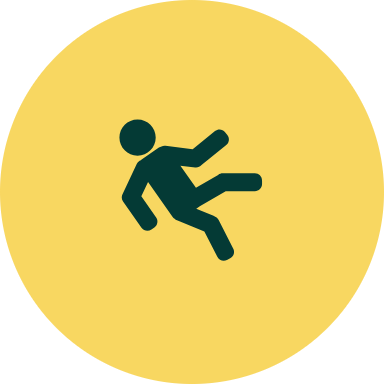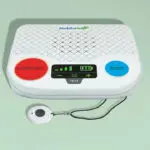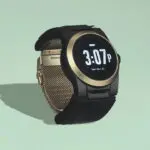Table of Contents
These products & services are researched and tested by HelpGuide’s independent consumer reviews partner. When you buy through the links, we earn a commission.
- When a medical alert system with fall detection detects a fall, it will automatically alert a monitoring center. If you don’t respond to monitoring center staff, they will send medical help.
- After testing 16 fall detection devices for ease of set-up, response time, and fall detection accuracy, the Handbook Team chose the Medical Guardian Mini Guardian as our top recommendation.
- Medical alert systems with fall detection cost around $31–$70 per month and $0–$350 upfront in equipment or activation fees.
Falling is a surprising, scary, and sometimes painful experience that’s even more traumatic when you’re unable to get up by yourself. Some people may wait an agonizing amount of time until they’re found, with one study reporting a median time of 13.5 hours spent on the ground. But it can take as little as one hour to develop dehydration, pressure sores, and an overwhelming sense of helplessness. As a result, people who’ve experienced what’s called a “long lie” are sometimes admitted to nursing home facilities sooner than anticipated.
Push-button medical alert systems help avoid long lies by allowing people to call for help even when they can’t reach a phone. But these basic systems require the person to be conscious and capable of using the button. Fall detection devices solve this problem by recognizing a fall and alerting the monitoring center automatically. If the monitoring center staff members don’t hear a response, they call 911 and send an ambulance to the person’s location.
Being down on the floor alone is a miserable, undignified experience for anyone, whether young or old. Rapid fall detection means restoring dignity.
Steve Moran, Senior Living Foresight
Because medical alert systems offer protection from long lies and other emergencies, fall detection devices can increase a person’s self-confidence, activity level, and sense of security. They also promote privacy, autonomy, and independence by allowing some people to safely age in place.
But not all fall detection devices are created equal. Medical alert systems and fall detection devices aren’t subject to FDA testing and approval, so they’re not held to any accuracy standards. The Handbook Team conducted our own series of fall detection tests to find the most reliable models. Below, we’ll help you find a device that fits your needs or your care recipient’s lifestyle.
Which fall detection device is right for you?
- Most sensitive on-the-go system: MobileHelp Micro.
- Fastest response time: Medical Guardian MGMini Lite.
- Most sensitive at-home system: Bay Alarm Medical SOS In-Home Cellular.
- Best value: MobileHelp Classic.
Why HelpGuide cares about older adult safety




Feelings of independence, security, and connection are closely related to older adult mental health. Older adults experiencing loneliness and social isolation tend to have a much higher risk of depression, anxiety, and suicide, as well as dementia, heart disease, and stroke, according to research.
Thankfully, studies have shown older adults who use medical alert systems have a greater sense of security, improved mental health, and are shown to be more active and independent around the home.
Independence is closely tied to one’s sense of identity, especially in older adults. Being able to perform daily tasks, make decisions, and live without constant assistance reinforces the feeling of being competent and valuable. A loss of independence can, unfortunately, erode this sense of self-worth.
Ryan Sultan, MD
For older adults, maintaining autonomy is directly related to mental health and quality of life. That’s why we’ve made it our mission to share the best information about medical alert systems that can help keep care recipients healthy, safe, and active.
Our Handbook Team hand-tests every medical alert brand we review, so we can feel confident recommending the best products for our readers. We consult with gerontologists (experts in older adult care), researchers, and industry leaders in older adult safety, as well as mental health experts, to vet our choices.
We also put ourselves in the consumer’s shoes by mystery shopping brands and walking through the set-up process, just like new customers. Additionally, we survey users and interview real people who use medical alert systems.
By compiling our testing data, interview and survey results, and insights from older adult care providers, we formulate a strongly informed perspective that we’re sharing with you here.
Learn more about our medical alert systems review methodology.
What you need to know about the best medical alert systems with fall detection
Our testing experience
In July 2023, the Handbook Team tested 18 fall detection devices from popular medical alert companies including Medical Guardian, Bay Alarm Medical, MobileHelp, LifeFone, Lively, and Medical Care Alert.
We evaluated how easy it was to set up each device using the provided instructions. Then, while wearing the necklace or watch, we pressed the help button to place a test call to the monitoring center. We recorded how long it took for a monitoring staff member to answer each call, then told them we were testing the equipment—something medical alert companies encourage users to do every month.
From our tester
“By the third test call, the monitoring center answered by saying, ‘Hi, Emily, are you still testing?’ So it seems like the monitoring center staff can track calls and offer a sense of personalization and connection with the agent.”
Our procedures varied depending on the type of system we were testing. For instance, while testing mobile medical alert systems, we asked monitoring staff to also identify our current location to check the accuracy of the GPS tracking. While for in-home systems, we stood 5 feet away from the base unit and evaluated how well we could hear the monitoring staff member.
Not every device passed muster at each stage in testing—and poor quality was duly noted.
From our tester
“Once we connected to the monitoring center, the staff member couldn’t hear us and calls kept dropping. We spent half an hour on the phone with technicians to resolve the issue. Even after the problem was fixed, audio quality was intermittently spotty.”
Next, we tested each device’s fall detection accuracy. In our experience, all detection devices are less likely to register a slow fall, like when someone slides out of a chair, than a hard and fast fall. This is why we conducted a series of three slow falls and three fast falls with each device.
- For the slow falls, we wore the medical alert system while sitting in a chair, then bent forward to put our knees on a mat. From there, we laid completely flat on our stomachs for at least 30 seconds.
- For the fast falls, we dropped each device from shoulder height and let it remain on the mat for at least 30 seconds.
We purposely focused on forward-facing falls, since falls on an outstretched hand (FOOSH falls) are one of the most common emergency room injuries.
It’s important to note that fall detection testing is not 100 percent accurate. That’s because studies are forced to use simulated falls in lab environments rather than data from real-world falls. To generate enough real-world fall data, researchers estimate we’d need to record about 100,000 days of activity. In the absence of real-world testing data, we read research papers and consulted with gerontologists to create our testing protocol, which most closely mimics real-world falls.
Only two models proved sensitive enough to detect all falls: the MobileHelp Micro and Bay Alarm SOS In-Home Cellular.
Did you know?
Stillness after rapid downward movement is one of the criteria these devices use to detect falls. Moving too soon after falling can cause the device to think you’re okay or able to press the button manually.
We timed how long it took the device to start calling the monitoring center. Then, we timed how long it took for someone to answer the call. We noted any time a device started a false alarm and, if applicable, tested the device’s call cancellation feature.
We also focused on two-way speaker quality, monitoring staff friendliness, lanyard adjustability, charging ease, and app functionality.
In addition to testing medical alert devices hands-on, we mystery shopped, spoke to brand customer service representatives, and interviewed independent senior health experts.
Compare the best fall detection devices
| Device | Starting monthly price | Fall detection monthly fee | Fall detection accuracy | In-home range (feet) | Mobile device battery life (days) | Learn more |
|---|---|---|---|---|---|---|
| $39.95 | $11.00 | 6/6 | N/A | 5 | Visit site | |
| $44.95 | $10.00 | 5/6 | N/A | 3 | Visit site | |
| $29.95 | $10.00; one-time fee of $30 | 6/6 | 1,000 | N/A | Visit site | |
| $19.95 | $11.00 | 5/6 | 1,400 | N/A | Visit site |
Reviews of the best automatic fall detection devices
1. MobileHelp Micro: Most sensitive on-the-go system
2. Medical Guardian MGMini Lite: Fastest response time
3. Bay Alarm Medical SOS Home Cellular with Fall Detection: Most sensitive at-home system
4. MobileHelp Classic: Best value
Other fall detection devices to consider
Unaliwear Kanega Watch: Fall detection in a smartwatch
Devices to avoid
Lively Mobile Plus: No falls detected
Lively Mobile Plus
Our verdict: The Lively Mobile Plus never registered our test falls.
The Lively Mobile Plus detected none of our falls. We even called customer service to make sure the fall detection feature was activated—and it was. The user guide notes using the belt clip disables fall detection. That wasn’t the problem in our case, but we were surprised that fall detection could be disabled by the user.
Although we can’t recommend the Lively Mobile Plus as a fall detection device, it performed well as a GPS tracker and felt lightweight around the neck. It’s also the only monitored medical alert device we’ve seen that allows users to directly call 911 by pressing and holding the button for five seconds.
Lively does charge a $35 activation fee, which is not clearly stated on the website or at checkout. Our testers also ran into trouble accessing the brand’s caregiver app without a Premium plan, even though it’s advertised as a perk for the Basic plan too.
What our testers say: “The Lively Mobile Plus did a poor job of fall detection during our tests. The lanyard isn’t adjustable, so it could be an awkward length. Also, the call center tells you more than once that the call will be recorded, which seems unnecessary and a waste of time.”
Summary of top fall detection device tests
| Brand | Device | Slow Fall Accuracy | Fast Fall Accuracy | Average time from fall to start of call | Average time from start of call to answer | Total average wait time |
|---|---|---|---|---|---|---|
| MobileHelp | Micro | 3/3 | 3/3 | 5 seconds | 33 seconds | 38 seconds |
| Medical Guardian | MGMini Lite | 2/3 | 3/3 | 6 seconds | 21 seconds | 27 seconds |
| Bay Alarm Medical | SOS Home Cellular | 3/3 | 3/3 | 5 seconds | 58 seconds | 63 seconds |
| MobileHelp | Classic | 3/3 | 2/3 | 10 seconds | 64 seconds | 74 seconds |
Pros and cons of fall detection devices
Fall detection devices can prevent or minimize physical and mental trauma that may occur when someone falls and can’t get back up for a long time. Breathing fluids into your airways during or after a fall can lead to pneumonia, and falling while showering or bathing can lead to hypothermia. People who remain on the floor for hours can become dehydrated and hungry, and they may experience side effects from missing medication. There’s also a risk of infection, pressure sores, muscle tissue breakdown, and hypothermia. If you’re seriously injured during the fall, you could experience a lot of pain and swelling before help finally arrives.
Fortunately, fall detection devices can help you or your care recipient avoid lying on the floor for extended periods, potentially minimizing mental trauma while providing a sense of security.
A fall detection device addresses the fear of falling by offering reassurance. A mobile device can provide the same sense of safety when you or your care recipient leave home independently.
What we like about fall detection devices
- Promote independent living: Fall detection devices can provide an alternative to in-home care and assisted living facilities in the right circumstances.
- Summon help automatically: Even if you can’t move or speak after falling, the device calls monitoring staff members, who dispatch first responders and notify caregivers.
- Connect to a monitoring center: Monitoring center staff members answer alerts 24/7, provide a personalized approach, and minimize false alarm dispatches.
- Provide peace of mind: It’s a relief to know that someone will be notified during an emergency.
- Help avoid a “long lie”: Long lies occur when someone falls and remains on the floor for more than one hour, and they can cause pressure sores, dehydration, and an increased risk of death within six to 12 months.
What we don’t like about fall detection devices
- Not guaranteed to detect all falls: Because some falls may go undetected, it’s still important to establish a check-in routine.
- May cause false alarms: Sensitive devices may call the monitoring center when you haven’t fallen, which some people may find irritating or distressing.
- May be taken off: People with memory problems may remove the device when they don’t understand its purpose, leaving them vulnerable.

How does fall detection work?
Fall detection devices contain a sensor called an accelerometer, which measures speed in relation to distance. The accelerometer feeds measurement data to a computer chip inside the device, where it’s analyzed according to an algorithm. The device is programmed to call the monitoring center if the algorithm reaches a certain threshold.
In practical terms, this usually means the device has to fall rapidly downward and then stop moving for two to 30 seconds to trigger a call to the monitoring center.
To increase the sensitivity of a fall detection device, some medical alert companies add extra sensors, like barometers (which measure air pressure changes), magnetometers (which measure the strength of the Earth’s magnetic field), or gyroscopes (which measure rotating motion). These extra sensors make it easier for the device to detect falls that happen slowly, like when a person leans against a wall and then slides to the floor.
Once someone from the monitoring center answers the call, they’ll speak to you through the device’s built-in speaker or through a speaker on a nearby base station. You can confirm you need help and ask them to call emergency services, a family member, or another caregiver.
If you can’t speak once the monitoring staff member answers the call, they’ll send first responders to your home or, in the case of GPS-enabled devices, to your location to check on you. It’s a good idea to keep a spare key in a lockbox by your front door so emergency responders can quickly get inside without damaging your home. Register the lockbox code with the monitoring center so they can share it when needed.
How falls affect your mental health
To learn more about the mental vulnerability that occurs during and after a fall, we spoke with Christina Peoples, a psychogerontologist, and Steve Moran, a senior living expert with Senior Living Foresight. Both say people can develop a fear of falling, which can become debilitating. “It keeps people from living a full life,” Moran says.
Fall detection is imperfect but more affordable and less intrusive than the alternatives. The right answer is to use a great fall detection system and then have a realistic understanding of the limitations.
Steve Moran, Senior Living Foresight
“Fear of falling can lead to social isolation because now the individual may be fearful to leave home or may avoid areas of their home where the fall occurred,” says Peoples. “Furthermore, the person might refrain from visiting familiar community spaces they typically enjoy due to large crowds, or they could be hesitant to venture anywhere alone. This can cause stress, depression, and anxiety, which all have an impact on an individual’s mental health.”
Peoples has seen firsthand how fall detection devices can boost morale. “I have a friend who is in her 70s and has a fall detection necklace,” she says. “She lives alone and often goes out in the community by herself, and she sees the device as something that prolongs her independence, not something that takes it away. She feels much safer knowing that she has support in case of a fall.”
How accurate is fall detection?
Every fall detection device we’ve seen comes with the same disclaimer: “Does not detect 100 percent of falls.” We agree with that statement for all fall detection devices—even the ones that registered each of our test falls. There’s too much variation in how someone could potentially fall—forward, backward, sideways, twisting, crumpled, hard, sliding, slowly, or quickly—to account for every single possibility in the device’s algorithm without causing too many false alarms.
That said, our tests showed some devices have better accuracy than others.
Because fall detection devices are never 100 percent accurate, it’s important to use them as part of a comprehensive safety strategy that includes fall prevention, like physical therapy and home modifications, plus fall detection and frequent caregiver check-ins.
The first thing people can do is work on strength and balance as much as possible to prevent falls. Other back-ups might include a cell phone or voice-activated services, such as Amazon Alexa.
Steve Moran, Senior Living Foresight
How much do medical alert systems with fall detection cost?

Medical alert systems with fall detection cost around $31–$70 per month and $0–$350 upfront in equipment or activation fees.
If you choose a fall detection device with no equipment fee, you’ll sign a lease agreement that holds you responsible for paying for a lost or damaged device, which can cost upwards of $350. Read the company’s full terms and conditions to avoid any surprises down the road.
Insurance coverage
You’re more likely to get coverage for a medical alert system through a long-term care policy than a health insurance plan, but it’s worth verifying coverage benefits with all providers. They may ask for a doctor’s note explaining why the device is necessary.
Unfortunately, medical alert systems aren’t covered by Medicare Parts A and B because they do not meet the definition of durable medical equipment. A Medicare Advantage (Part C) plan may provide coverage for medical alerts, but it’s uncommon.
Your state’s Medicaid program may cover medical alerts under long-term care benefits.
How to save money
- Look for a medical alert company that offers a discount when you choose an annual plan.
- Talk to a sales representative over the phone—they’re sometimes allowed to give extra discounts.
- Look for discounts offered through membership programs like AARP.
- Ask your local Area Agency on Aging about available discounts or grants.
Note: Veterans Affairs does pay for a few mobile medical alerts (MedEquip, Latitude, and LogicMark), but none include fall detection.
Key features of medical alert systems with fall detection
In addition to an accurate fall detection sensor, look for these features when shopping for a fall detection device:
- Adjustable lanyard.
- Lightweight design.
- Clear two-way audio.
- Easy-to-use charging cradle.
- Water-resistant case.
- Automatic caregiver alerts when a fall is confirmed by the monitoring center.
- Caregiver app that shows device battery.
Our final verdict
Based on our tests, these devices are more likely to detect falls and give you the peace of mind you’re looking for:
Your final choice boils down to whether you want an in-home or mobile system, how much you want to pay, and whether you’d like to cancel false alarms before the monitoring center picks up. Each brand employs helpful, friendly, and easy-to-understand people in their monitoring centers, ensuring your care recipient gets empathetic and fast support during an emergency.
Frequently asked questions
Yes, we think fall detection is worth it. While your loved one may never actually need it, knowing that it could quickly summon help during an emergency can give them (and you) peace of mind. Fall detection devices also prevent or reduce the physical and mental deterioration associated with lying on the ground for hours at a time.
No, not usually. Fall detection devices use cellular networks to connect to the monitoring center, but consumers do not set up or pay for a SIM card or cell plan. It’s all handled by the medical alert company.
Smartwatches with fall detection, like the Apple Watch, are the exception to the rule. In order for the device to call 911 or an emergency contact, you do need a SIM card or cellular plan.
Yes, all Apple Watches released in 2018 or later have fall detection. That includes the Apple Watch Series 4, the Apple Watch SE and SE 2, and the Apple Watch Ultra.
- Ang, G. C., Low, S.L., and How, C.H. (2020). Approach to falls among the elderly in the community. Singapore Medical Journal, 61(3), 116-121. Link
- Bet, P., Castro, P.C., and Ponti, M.A. (2019). Fall detection and fall risk assessment in older person using wearable sensors: A systematic review. International Journal of Medical Informatics, 130(). Link
- Broadley, R., Klenk, J., Thies, S., Kenney, L., & Granat, M. (2018). Methods for the real-world evaluation of fall detection technology: A scoping review. Sensors, 18(7), 2060. Link
- Centers for Disease Control and Prevention. (2021, April 21). Loneliness and social isolation linked to serious health conditions. Link
- Crenshaw, J.R., Bernhardt, K.A., Achenbach, S.J., Atkinson, E.J., Khosla, S., Kaufman, K.R., and Amin, S. (2017). The circumstances, orientations, and impact locations of falls in community-dwelling older women. Archives of Gerontology and Geriatrics, 73(), 240–247. Link
- Hüser, C., Hackl, M., Suárez, V., Gräff, I., Bernhard, M., Burst, V., and Adler, C. (2023). Liegetrauma: retrospektive Analyse einer Patientenkohorte aus einer universitären Notaufnahme [“Long lie trauma” patients: retrospective analysis of a patient cohort presenting to a university hospital emergency department]. Medizinische Klinik, Intensivmedizin und Notfallmedizin, 118(3), 220–227. Link
- Lee, Y., Pokharel S., Al Muslim, A., KC, D.B., Lee, K.H., and Yeo, W.H. (2023, March 14). Experimental study: Deep learning-based fall monitoring among older adults with skin-wearable electronics. Sensors, 23(8), 3983. Link
- Medicare.gov. Durable medical equipment (DME) coverage. Link
- Milat, A.J., Watson, W.L., Monger, C., Barr, M., Giffin M., and Reid, M. (2011). Prevalence, circumstances and consequences of falls among community-dwelling older people: Results of the 2009 NSW Falls Prevention Baseline Survey. NSW Public Health Bulletin, 22(), 3-4. Link
- Roush, R.E. and Teasdale, T.A. (2011). Personal emergency response services: Do the benefits justify the cost in seniors housing and care properties? Seniors Housing & Care Journal, 19(1), 73-82. Link
- Stokke, R. (2016). The personal emergency response system as a technology innovation in primary health care services: An integrative review. Journal of Medical Internet Research, 18(7), e187. Link
- Thoder, J. (n.d.). Broken a fall with your hand? How to prevent a foosh injury. Temple Health. Link
- Wang, X., Ellul, J., and Azzopardi, G. (2020). Elderly fall detection systems: A literature survey. Frontiers in Robotics and AI, 7(). Link
- Wild, D., Nayak, U.S., and Isaacs, B. (1981, January 24). How dangerous are falls in old people at home? British Medical Journal (Clinical Research Edition), 282(6260), 266-268. Link
- Zheng, L., Zhao, J., Dong, F., Huang, Z., and Daidi, Z. (2023). Fall detection algorithm based on inertial sensor and hierarchical decision. Sensors, 23(1), 107. Link




















